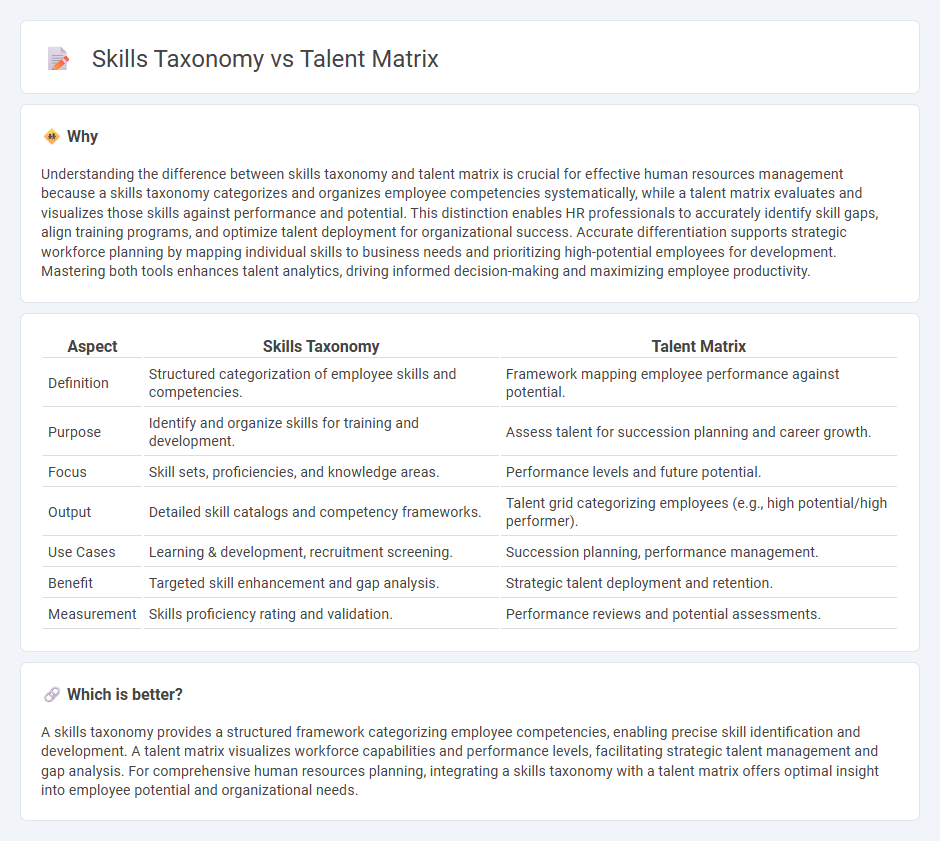
Skills taxonomy organizes employee abilities into a structured framework, categorizing competencies based on roles, proficiency levels, and industry standards to streamline workforce development. Talent matrix evaluates individual performance and potential within this framework, enabling targeted talent management and succession planning. Explore how aligning these tools enhances organizational efficiency and employee growth.
Why it is important
Understanding the difference between skills taxonomy and talent matrix is crucial for effective human resources management because a skills taxonomy categorizes and organizes employee competencies systematically, while a talent matrix evaluates and visualizes those skills against performance and potential. This distinction enables HR professionals to accurately identify skill gaps, align training programs, and optimize talent deployment for organizational success. Accurate differentiation supports strategic workforce planning by mapping individual skills to business needs and prioritizing high-potential employees for development. Mastering both tools enhances talent analytics, driving informed decision-making and maximizing employee productivity.
Comparison Table
| Aspect | Skills Taxonomy | Talent Matrix |
|---|---|---|
| Definition | Structured categorization of employee skills and competencies. | Framework mapping employee performance against potential. |
| Purpose | Identify and organize skills for training and development. | Assess talent for succession planning and career growth. |
| Focus | Skill sets, proficiencies, and knowledge areas. | Performance levels and future potential. |
| Output | Detailed skill catalogs and competency frameworks. | Talent grid categorizing employees (e.g., high potential/high performer). |
| Use Cases | Learning & development, recruitment screening. | Succession planning, performance management. |
| Benefit | Targeted skill enhancement and gap analysis. | Strategic talent deployment and retention. |
| Measurement | Skills proficiency rating and validation. | Performance reviews and potential assessments. |
Which is better?
A skills taxonomy provides a structured framework categorizing employee competencies, enabling precise skill identification and development. A talent matrix visualizes workforce capabilities and performance levels, facilitating strategic talent management and gap analysis. For comprehensive human resources planning, integrating a skills taxonomy with a talent matrix offers optimal insight into employee potential and organizational needs.
Connection
Skills taxonomy categorizes and defines the competencies required across various roles, enabling precise identification of employee capabilities. Talent matrix maps these categorized skills against individual performance and potential, facilitating strategic talent management and development. Integrating both tools enhances workforce planning by aligning skill gaps with business objectives and optimizing employee growth pathways.
Key Terms
Performance-Potential Grid
The Performance-Potential Grid is a key component of the talent matrix, categorizing employees based on current performance and future potential to drive targeted development and succession planning. Skills taxonomy, by contrast, organizes and defines specific competencies and skills required for various roles, facilitating skill gap analysis and learning pathways. Explore how integrating both frameworks enhances talent management effectiveness and organizational growth.
Competency Mapping
Talent matrix and skills taxonomy are essential frameworks in competency mapping, each serving distinct but complementary purposes. Talent matrix visually categorizes employees based on performance and potential, enabling targeted development, while skills taxonomy systematically organizes skills and competencies into hierarchical structures to facilitate precise identification and assessment. Explore further to understand how integrating these tools enhances talent management and organizational development.
Skill Categorization
Talent matrix organizes employee competencies by performance and proficiency levels, highlighting gaps and growth opportunities within teams. Skills taxonomy categorizes abilities into hierarchical groups, providing a structured framework for identifying and managing specific skills across an organization. Discover how integrating these tools enhances strategic talent management and workforce development.
Source and External Links
How to Create a Talent Matrix for your Company - A talent matrix is a tool used by organizations to assess employee performance and potential, typically via a 9-box or 16-box grid, facilitating development and succession planning through defining performance/potential metrics and manager discussions.
Mckinsey 9 Box Talent Matrix: A Practical Guide for HR ... - The 9-box talent matrix divides employees into nine categories based on performance and potential, helping organizations identify future leaders ("stars") and plan targeted development and rewards accordingly.
9 Box Grid: A Practitioner's Guide [FREE Template] - The 9-box grid segments employees by performance and potential on a 3x3 grid, enabling targeted talent management and fostering a growth mindset by carefully communicating evaluations.
 dowidth.com
dowidth.com